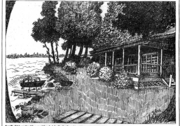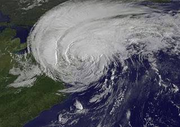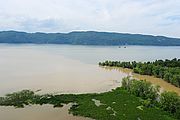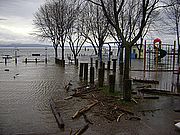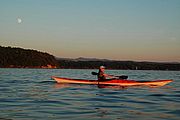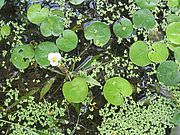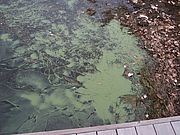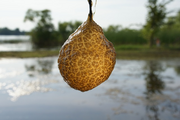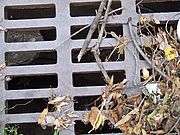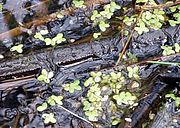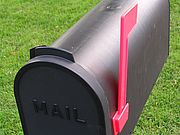Join the Rozalia Project, LCC and other lake friends in a lakeside cleanup as part of the International Coastal Cleanup (ICC). The ICC is the world's largest effort for ocean (and lake) health with millions of volunteers from over 150 countries cleaning their lakes, rivers, bays and oceans. Registration begins at Burlington’s Community Sailing Center (CSC) at 12:30 PM Saturday, September 17, followed by a waterfront cleanup from 1:00 PM-3:00 PM, capped off by a Trash Bash from 3:00 PM–4:00 PM featuring food and give-aways. Hand in your trash and data cards, try your luck at some great prizes, and check out the slide show presentation by Rachael Miller of Rozalia Project documenting their summer adventures picking up marine debris, freeing entangled creatures and working for clean water...MORE Read...
News from Selected Month
Please join Lake Champlain Committee board, staff and friends at "The Big House" at Sunnywood in Chazy, New York on Saturday, October 1st from 2:00 PM-5:00 PM for our 48th Annual Meeting. Learn about LCC’s work and lake issues, get a guided tour of the Sunnywood family compound, and enjoy a light fare of savory and sweet treats from area purveyors. Bill Howland, Manager of the Lake Champlain Basin Program, will give the guest address on the “Great Floods of 2011”. He will present a dramatic slide show covering historic spring flooding, Tropical Storm Irene and how we can protect our waterways in the future followed by a question and discussion period. Directions and further details will follow in a subsequent email...MORE Read...
Between 7:00 AM and 4:00 PM on Sunday August 28th Lake Champlain rose approximately three feet according to the gauge in Whitehall, NY at the southern end of the lake. Over the same time span the gauge at Rouses Point at the northern end of the lake suggested lake level had dropped by over a foot. The winds of Tropical Storm Irene, with sustained winds over 35 knots (40 mph) and gusts up to 45 knots (52 mph), had pushed the surface water of the lake south where it piled up in Whitehall...MORE Read...
Tropical Storm Irene delivered another slug of nutrients and sediments to Lake Champlain along with tremendous quantities of debris causing challenges for navigation. Boaters should use extreme caution on the water. Conditions are particularly treacherous at night. Read...
Lake Champlain was above flood stage for two months this spring. The record flooding that occurred in New York, Vermont and Quebec has led to calls for the governments to ‘do something’. Vermont Governor Peter Shumlin and Quebec Premier Jean Charest have asked President Barack Obama and Canadian Prime Minister Stephen Harper to charge the International Joint Commission (IJC) with researching ways to reduce flooding near Lake Champlain and the Richelieu River. The IJC is responsible for overseeing international boundary waters...MORE Read...
On Friday August 26th the 402 foot center span for the new Champlain Bridge was floated from Port Henry to Crown Point, lifted into place, and secured to the east and west bridge approaches. Now bridge construction enters its home stretch. Outstanding work includes adding the deck of the center span, attaching pedestrian sidewalks outside the arch, and completing various finishing touches. The $69.9 million bridge is expected to be completed before the end of the year according to John Grady, construction engineer for the New York State Department of Transportation. Until the bridge is completed the ferry that provides 24-hour service between Vermont and New York will continue to operate. Click here for visual updates of the bridge construction. Read...
Late summer and early fall are wonderful times to be out on the water. Be sure you have the 2011 edition of the Paddlers’ Trail guidebook in tow. It’s filled with important information for great adventures on the water including site descriptions and chartlets for 39 Trail locations (with access to over 600 campsites), launch site listings, natural history articles, safety and stewardship tips, equipment check lists and more! - And it's available to all members who renew annually for $45 or more. Click here to make an online donation to ensure you have the guidebook in hand for the rest of this paddling season. Happy, safe adventures on the water! Read...
A new population of European frog-bit was discovered during a plant survey in Missisquoi Bay. Researchers from LCC and Arrowwood Environmental had been surveying the plant communities (video) when they came across the population in an isolated embayment near the mouth of Dead Creek on the eastern side of Missisquoi Bay. “It’s a small population with a few scattered individual plants which we removed,” reported LCC Staff Scientist Mike Winslow.
The plant survey is funded by a grant to LCC from the Lake Champlain Basin Program. LCC’s aquatic mapping and removal project is proactive, seeking and eradicating invasive plant populations before they become established. Once a species becomes established, eradication is infeasible in most situations. Our work can prevent species from expanding in the lake. By the end of August, more than half of the Missisquoi Bay plant community had been sampled. Work is expected to continue through September. Read...
The 2011 blue-green algae monitoring season is winding down. This year following spring flooding, blooms in Missisquoi Bay were extensive and thick. Additional persistent blooms were found in St. Albans Bay and sporadic blooms occurred throughout other portions of the lake. For information about the latest status of algae blooms on Lake Champlain visit LCC’s website or the Vermont Department of Health’s blue green algae page.
Each summer since 2004 LCC has partnered with the University of Vermont Rubenstein Lab, to expand blue green algae monitoring on Lake Champlain. LCC helps train and oversee citizen monitors who take weekly water samples from select shoreline areas. We also monitor several shoreline beaches, do visual site checks at additional locations, and serve as a first responder when blooms are underway. This award-winning program, which LCC initiated, provides critical data on where and when blooms are happening. The information we gather is used by public health officials to assess whether the water is safe for swimming. Our dedicated group of volunteer monitors go out once per week from early July through Labor Day to collect samples and take them to designated drop-off locations. Read...
Brown jelly-like blobs have been reported from various places around Lake Champlain this summer. The patterning on the surface of the blobs makes them resemble brains or diseased tree branches. These are actually colonies of sessile invertebrate animals called bryozoans. While the blobs may range from golf ball to melon-sized, each individual in the colony is microscopic. Most bryozoan species live in marine environments, but 50 species are known from freshwater including 21 from North America. The species most commonly observed in Lake Champlain is probably Pectinatella magnifica. Bryozoans tend to grow on wood or other vegetation in areas where the water is quiet. They do not tolerate polluted conditions and require fairly high oxygen levels in the water. Occasional summer outbreaks have been recorded on other waterbodies, but it is unclear why they happen. Read...
One small step you can take to minimize damage from storms to local roads and waterways including Lake Champlain is to clear any storm drains in your neighborhood. When storm drains clog, the water that they are designed to collect bypasses the drains and erodes at road beds. In addition to weakening the road the eroded soils wash into water bodies adding to the pollution load from storms. Unclog the drains by simply removing any debris on the grate or blocking water’s access to the grate. It’s a small step, but every little bit helps. Read...
As the kayak glides through the still water of a marshy bay it parts the green verdure floating on top. A bullfrog sits camouflaged amidst the tiny leaves. This is no algae bloom. Each spot of green is a separate little plant, the smallest of the rooted plants. Duckweed.
Due to their small size, duckweeds are often confused with algae. Like algae they can proliferate and cover stagnant regions of nutrient rich water. Quiet backwater bays, stormwater ponds, farm ponds, and slow-moving lowland streams can be filled with the plants. If the water is not stagnant, duckweeds simply blow away and the population never builds up. So, unlike algae blooms, which can appear anywhere on the lake, duckweeds’ range is more restricted... Read...
If you’ve had an address change recently, please send us an email so we can update your files and ensure you receive news on lake issues and LCC’s work. Our primary form of communication with members is through email. By mailing electronically we save time and resources and reinforce the stewardship ethic of our mission. We don’t give away or sell email addresses. To ensure that our email messages get through to your inbox, please add lcc@lakechamplaincommittee.org and the domain enews.lakechamplaincommittee.org to your safe/allowed list and address book. Thanks! Read...

